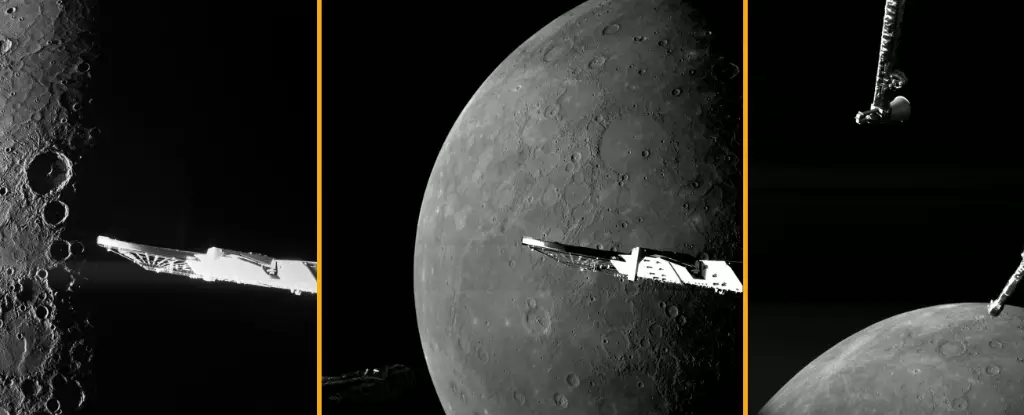The exploration of Mercury, the innermost planet in our solar system, has long been a formidable challenge for scientists due to its adverse conditions and proximity to the Sun. Recent findings from the European Space Agency (ESA)’s BepiColombo mission have opened a new chapter in our understanding of this enigmatic world. During its latest flyby, the spacecraft captured breathtaking close-up images from just 295 kilometers above the planet’s surface. These photographs reveal Mercury as a planet of stark contrasts, where areas of perpetual darkness meet the dazzling brightness of crater edges caught in continuous sunlight.
The captured images indicate that within the depths of these shadowed regions, there exists a frozen reservoir of ice, which possibly harbors vital ancient secrets about Mercury’s geological history and evolution. This ice may unlock answers to questions about the planet’s past climate and its potential for hosting water in other forms, paving the way for future explorations. As Geraint Jones, ESA’s Project Scientist, highlighted during the agency’s annual press briefing, the team is positioned to analyze and interpret an abundance of data from this flyby. With significant findings to unravel in the coming weeks, the scientific rigorousness expected from the BepiColombo team signals a committed effort to deepen our understanding of this fascinating planet.
Mercury’s unique and extreme environment is characterized by its close orbit to the Sun, averaging just 58 million kilometers away. This proximity subjects the planet to relentless solar radiation and the abrasive effects of solar winds, leading to an atmosphere that is almost negligible. At the sunlit surface, temperatures soar to a blistering 430 degrees Celsius (over 800 degrees Fahrenheit), while the obscured dark regions plunge to frigid lows of minus 180 degrees Celsius. The stark temperature differentials paint a graphic image of Mercury’s inhospitable climatic extremes, which have long posed a barrier to exploration and discovery.
Yet underneath this harsh exterior lies a trove of meteorological secrets, including a perplexing magnetic field and considerable deposits of carbon, possibly in diamond form. These discoveries underscore the complex geological dynamics at play within Mercury, including a possible gradual shrinkage of the planet over time. As humanity develops vision and technology to delve deeper into such mysteries, the implications of these findings may redefine our understanding of planetary formation and behavior.
The Journey of BepiColombo
Since its launch in October 2018, BepiColombo has embarked on a pioneering mission to decode the secrets of Mercury’s magnetic field, gaseous atmosphere, and intricate surface geology. Equipped with advanced monitoring cameras, the spacecraft has relayed exquisite images of Mercury while also capturing scenes of Venus during its transit. These exhilarating snapshots of not only the handsome terrains of our Solar System but also the varied elements at play have provided invaluable insight into the historical changes Mercury has undergone over eons.
Among the noteworthy features residents on the planet’s surface is the Nathair Facula, indicative of Mercury’s most substantial volcanic eruption, exhibiting a vent of approximately 40 kilometers in width at its core. The nearby Fonteyn crater, relatively youthful at 300 million years old, shines through the seemingly aged landscape—a powerful reminder of Mercury’s ongoing geological activity.
Come 2026, the ambitious BepiColombo mission is set to deploy the ESA’s Mercury Planetary Orbiter alongside Japan’s Mercury Magnetospheric Orbiter, marking the dawn of a new era in Mercury exploration. These orbiters are designed to operate at strategic altitudes that will enable them to gather detailed data about Mercury’s composition and behavior, albeit from a distance that maintains a safe margin over the planet’s surface.
In essence, as BepiColombo prepares to delve into its primary mission phase scheduled for 2027, we stand on the precipice of transformative discoveries about Mercury and its myriad secrets. The combination of cutting-edge technology and sustained scientific inquiry ensures that the future holds a more comprehensive understanding of one of our solar system’s most peculiar planets. As we continue to explore our cosmic neighborhood, it is likely that Mercury, with its unique traits and mysteries, will capture the imaginations of scientists and enthusiasts alike for years to come.


Leave a Reply